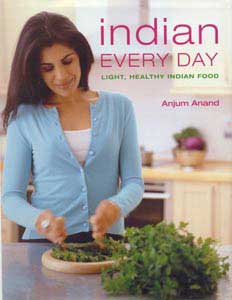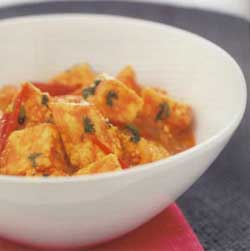Arts
Eat, Drink And Be Svelte

Anjum Anand offers secrets for light, healthy Indian food.
|
Another new year has dawned but we are certainly carrying something from the old year with us into 2005 – those pounds we had sworn to lose in 2004! Yes, you can lose your keys, your money, your eyeglasses, but excess weight stays stubbornly right with you! Now help is on the way with Anjum Anand’s cooking secrets – Indian Every Day: Light, Healthy Indian Food.
Light, healthy Indian food may sound almost like an oxymoron – after all, we are used to eating restaurant food drowning in butter and cream. Anand, who is based in London, gives you all the traditional dishes, but recreates them in lighter versions. She too had an addiction for rich Indian food and battled with weight gain throughout her growing years. You see her on the cover of her book – young, sleek and as fresh as the cilantro she is chopping – and you’d think, she couldn’t ever have had a weight problem. But Anand says she has lost over 75 pounds of “puppy fat” without going on crazy diets. She says in the book, “This millennium is about healthy eating. No more starvation diets, no more elimination diets, no more raw food, no more color co-coordinated diets, no more, no more, just say no! This millennium is about feeling good about yourself.” The answer, she discovered, was two-fold. Firstly, it was imperative to follow a varied diet with wholesome ingredients and limited oil. The second part of the answer was even more important and almost involved a change in behavior: “I realized this was the beginning of the rest of my life. I would have to adopt this new eating plan for the rest of my life. It made sense really as most people revert to their old eating habits and undo all the good work they have done.” She followed this mantra of healthy eating and slowly, but surely, lost the weight. She says: “I advise anyone embarking on a diet, to ask themselves if they could actually follow the diet they want to follow for a long, long time. Many fad diets aren’t sustainable. I know it is boring, but in my experience a sensible diet will give you the lasting results you are looking for.” Anand worked at the trend-setting Café Spice in New York and for Tommy Tang at the Mondrian hotel in Los Angeles. She has also appeared on the Food Channel’s “Good Food Live Show” and knows a thing or two about giving traditional food a fresh new look with contemporary, healthy touches. In her hands, Indian food is simpler and fresher, with jewel like garnishes and spices that provide the taste, rather than relying on oil. As she points out, Indian food is, in fact, very healthy. A typical Indian meal is really well balanced and would consist of a lentil (protein and minerals) curry, a non-vegetarian (protein) curry, a vegetable dish and a complex carbohydrate (wholemeal flat-bread or rice). Add to this a bowl of yoghurt (minerals) and you have all the food groups represented with a healthy dose of vitamins and minerals. “Also, the basic ingredients used in Indian cooking are inherently healthy,” she says. “Foods that the scientists call super-foods with healing properties such as ginger, garlic, chilies, tomatoes and the different spices. For example turmeric is an antiseptic. I think the whole world should eat this way.” So how does one go about transforming traditional rich cooking into light, guilt-free food that you can eat every day? After all, we all want our Murgh Malai Tikka, our kulfis and kheers! “The only thing you would need to do to make your Indian meals healthy is to reduce the amount of oil you use in your favorite recipes and buy non-stick pans,” she says. ” We all have such busy and full lives that few of us eat the accepted three meals a day at a table. More often than not we are grabbing something on the run or have little time to cook for ourselves.” To help organize busy lives, she offers an assortment of recipes in the book for both everyday cooking and party dishes and the bonus is that all of them are calorie conscious and can be whipped up in a short time. She says she’s included recipes for every situation from “from creating a lavish and impressive Indian feast for friends and family to throwing leftovers into a pan and creating a healthy meal in minutes for yourself.” While most of her dishes stem from traditional northern Indian cooking, she has added regional fare as well as dishes that came about as a result of her own experimentation. As she likes to say, “The recipes are a modern take on authentic home-style Indian recipes. I employ healthy cooking techniques, with modern and convenient ingredients to create a variety of dishes, both spicy and mild.” Indian Every Day has some innovative recipes and the photography is luscious enough to eat! The book is about sensible eating for the long haul, and none of the dishes give calorie components. So there is not an obsession with calories, but home cooking is tweaked to make it healthy and low in calories by selecting lean and low-fat alternatives. Thus you can indulge in Goan Prawn Curry, Methi Ke Naan or Murgh Makhani, or even eat desserts like Gajjar Ka Halva or Shahi Tukra. If you are addicted to Meetha Poora, crispy sweet griddle cakes, which are deep fried breads traditionally, Anand’s version which is pan-fried rather than deep-fried, allows you to indulge. She also has wonderful, earthy vegetarian dishes which give a tweak to traditional dishes: the Ghiya Ka Kofta Curry (Veggie Dumpling Curry) once again allows you to enjoy koftas without frying them. Masale Wali Arbi (Spiced Colocasia) ends up looking like a gourmet dish. Besides the recipes, Anand also has several tips for the time-deprived and novices, such as how to transform leftovers, the correct way for freezing small items like samosas or what the shelf life of various cooked foods should be. Ever wondered how long the paneer or the kulfi should sit in the freezer? The answer is in the book. Anand, who loves to travel, brings back international recipes from visits to Greece or Turkey and incorporates them into her repertoire. Thus you have Meethi Dahi Ki Malai (Sweetened Yogurt Cream). It does not contain any rich malai and is actually made out of Greek yogurt. The book has been very popular in the U.K. and Anand was delighted to find that it had become a best seller in her favorite bookstore. She says: “The British love Indian food. It is the most popular cuisine in the country with, ostensibly, more Indian restaurants in London than both Delhi and Bombay combined!” Very often, Indian food, notorious for grease, fried ingredients, sugar and cream, gets no respect from dieters. But done right, it can be the dieter’s best friend. Says Anand: “Indian food, often the culprit for my falling of the healthy eating wagon, was my saving grace and it still keeps me firmly on track.” YOU DON’T NEED FAT TO BE THIN
|


 2 tbs vegetable oil
2 tbs vegetable oil 1 liter (11/2 pints) semi-skimmed milk
1 liter (11/2 pints) semi-skimmed milk 3 tbs mustard or vegetable oil
3 tbs mustard or vegetable oil